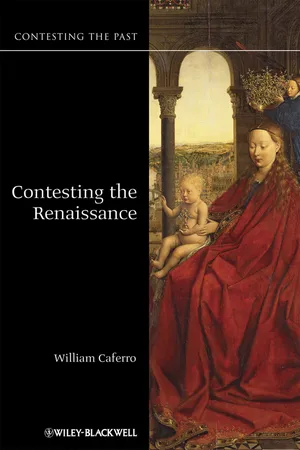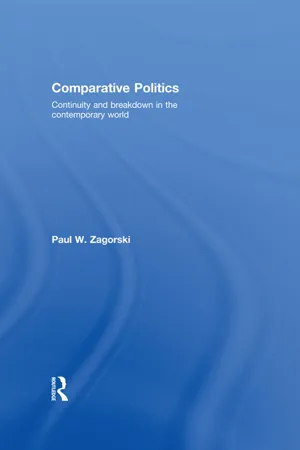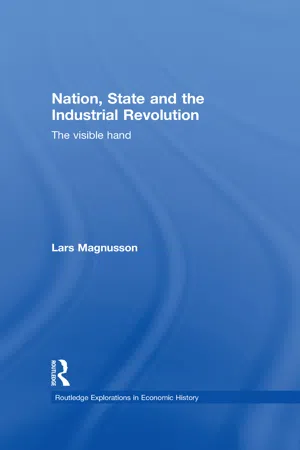History
New Monarchies
"New Monarchies" refers to a period in European history during the late 15th and early 16th centuries when monarchs consolidated power and centralized authority within their realms. This era was characterized by the emergence of strong, centralized states, often through the use of administrative reforms, increased taxation, and the establishment of standing armies. The new monarchies played a significant role in shaping the political landscape of early modern Europe.
Written by Perlego with AI-assistance
Related key terms
5 Key excerpts on "New Monarchies"
- eBook - ePub
- William Caferro(Author)
- 2010(Publication Date)
- Wiley-Blackwell(Publisher)
The papacy is perhaps the most problematic of all. It functioned as a kind of elective monarchy, but with much greater claims to sovereignty and its own laws that theoretically applied to all of Christendom. The monarchies in Southern Italy resembled in some respects the centralizing nation states up north. Alan Ryder has argued that the Aragonese king Alfonso the Magnanimous, who ruled the kingdom of Naples in the middle of the fifteenth century (1442–1458), reformed the state along the lines of the New Monarchies, centralizing the bureaucracy and restructuring the army. 64 Scholars have also seen elements of Weberian modern bureaucracy in lordly courts at Ferrara and in the Romagna. 65 Political centralization in Italy had, however, its own distinctive aspect. The political disputes and wars of the fourteenth and fifteenth century led to the consolidation of power on the peninsula. By the middle of the fifteenth century, the political landscape was reduced from numerous small independent states to five major “Renaissance” states – Venice, Florence, Milan, the papacy, and the Kingdom of Naples. They were territorial states, grown large by incorporating neighboring towns and lands. The territorial states have been the subject of much recent discussion. Scholars have investigated the nature of their political organization, relations between the “center and periphery,” dominant cities and their satellites. As with Northern European states, there was an early tendency to emphasize centralization and modernity. But current research has stressed the persistence of “particularism” over central authority, seeing the states as “aggregations” of diverse centers of power. Giorgio Chittolini argued that even where centralized power developed, Italian states were too distinct to be considered “modern” in any real sense. P. J - eBook - ePub
Comparative Politics
Continuity and Breakdown in the Contemporary World
- Paul W. Zagorski(Author)
- 2012(Publication Date)
- Routledge(Publisher)
The methods used by centralizing monarchs were far superior to older methods. With this rudimentary modern state, the monarch could collect taxes – and in real money! – and did not have to rely on feudal payments in kind. With money, a king could hire himself a professional army, or, at least, add a professional component to his feudal array. Professional troops could be brought into the field in the numbers and at the times the king chose. Professional troops could be trained and equipped with the latest arms – artillery and firearms. With a trained corps of judicial officials, the king’s law and the king’s peace could be imposed throughout the realm, and not checked and sidetracked by the local nobility. Such organization was superior in terms of efficiency and power to its feudal predecessor. The church and the nobility saw the basis of the strength eroded. Despite their efforts to push back, eventually the role of the pope and the church was diminished as was the nobility’s. By the sixteenth century, the Protestant Reformation put many churches under national control. And in Catholic countries, popes normally signed concordats (legal agreements) that ceded to the king the authority over appointments he most sought in exchanges for the preservation of church lands and church control of education and family law. Even so, some Catholic monarchs took it upon themselves to unilaterally divest the church of much of its property. The practice would expand as republican governments eventually replaced monarchies in the nineteenth century. In short, successful monarchs created the rudiments of a modern state. A monarch who commanded a proto-modern state could more easily take advantages of his domain’s resources and control his traditional domestic political competitors (Diamond, J. 1997: 265–92).The Emergence of New Actors and IdeologiesSuccessful monarchs managed to create something like the prototype modern state, but the political strategy that created the state had unintended consequences as well. The creation of the state and the centralization of royal power also promoted economic and social change that gave increasing prominence to actors and ideas that had been marginal in the medieval epoch. In the seventeenth and eighteenth centuries the rise of absolute monarchs such as the “Sun King,” Louis XIV of France, heralded the end of the medieval constitution and the beginning of a new era in which absolute monarchs controlling states competed with one another for power and glory. Monarchs had changed the legal rules so decisively and the de facto power of weaker political players strengthened so much that a new system had emerged. Key among these was the middle class. - eBook - ePub
- Fabio de Nardis(Author)
- 2020(Publication Date)
- Palgrave Macmillan(Publisher)
1953 ).The feudal structure was not the only way power was organised. The Church, too, had established a complex system of ecclesiastical offices and hierarchies that were distributed throughout the territory , conditioning the secular power systems. Moreover, in the perception of political elites, the memory of the Roman Empire remained clear and, therefore, also the awareness of a power system that could avoid feudal fragmentation. The competition for power through military conquests led to a gradual reduction of the centres of power, allowing only some of them to extend their dominion over wider portions of territory . In order to retain control over a larger area, the political control was also intensified and became more continuous and organised. These political developments were also possible thanks to social advances that favoured their dynamics: think of the construction of increasingly dense road networks, which facilitated communication even between distant areas, or progress in military technology that allowed the formation of armies able to defeat fearsome enemies and incorporate areas of the territory into a single centre of power.These mechanisms laid the foundations for the slow overcoming of feudalism and the gradual definition of the post-feudal phase that took place in the Staendestaat , that is in a system of government based on “estates ” (Poggi 1990 ). We are therefore in that long transition phase that covers roughly the period from the twelfth to the sixteenth century. This was the time when the historical conditions for the construction of modern states on the ashes of feudalism were created. The great princes began to benefit from elevated public privileges, surrounding their person with a great degree of majesty, reinforced by a system of sacred rituals and ceremonies. Alongside the prince, and often in opposition to him, a multiplicity of organisms were formed, from local deliberative assemblies, to municipalities, to ecclesiastical and trade corporations that reveal an increasingly dynamic society, with a differentiation of social interests that were organised in “estates”, acting as collective bodies. If he wanted to maintain his power, a prince could no longer govern as if such interests did not exist but had to periodically convene the assemblies of the statuses , agreeing with them the main political and administrative actions. Society had broken into politics, which ceased to be a mere exchange between self-centred Lords. Those who held political power now needed a degree of social consensus - eBook - ePub
- Lars Magnusson(Author)
- 2009(Publication Date)
- Routledge(Publisher)
camera was replaced by many specialized functions and bodies. In order to govern special departments, bureaus and collegiums were inaugurated and soon swelled with staff.Alongside this, the monarch was able to break the power of his former vassals. In many places a nobility of independent landlords and military leaders was replaced by a court nobility controlled by the king and his administration. Often used to illustrate this transition to absolute monarchy are the House of Tudor in England and the Valois dynasty in France. With King Louis XI (ruling 1461–83), the French monarchy could establish a more effective grip over its counts and barons in the countryside. Over the next century, royal power was challenged on several occasions and the threat of civil war was never far away. Most well known is the cataclysmic strife between Huguenots and Catholics which began after Henry II so unfortunately fell off his horse and died in 1559. Until Louis XIV came to power in 1661 (and provided the world with a standard for how an absolute ruler should govern) weak monarchs (Louis XII) were followed by stronger ones (Francis I, Henry of Navarre). After the rebellion of the Fronde (starting 1648) both the local parliaments and the particularistically minded nobility were dethroned as centres of power – at least according to the orthodox version of French political history.The emergence of ideologues such as Laffemas and Montchrétien at the beginning of the 17th century also signalled the establishment of new ideas with regard to economic policy; i.e. how economic means could be used in order to increase the power and influence of France. On this basis, after 1660 the so-called Colbert system was established. The ‘system’ of Louis Colbert, the finance minister to Louis XIV, included the abolition of internal tariffs and duties. With this a first step was taken to establish a national market for France (though some would say this did not really become a reality before the end of the 19th century).5 With regard to external trade, Colbert suggested high and penalizing tariffs on most kinds of industrial imports. The main reason for this was that he believed that the future lay in many more manufactures and the establishment of an industrial economy. In order to create the basis for a growing manufacture sector Colbert proposed a system of protection. However, he also developed a system in which this sector was heavily subsidized by the state. And he supported the establishment of a public manufacture sector, for example in textiles, glass, fayance, metal and steel smithies, etc.6 - eBook - ePub
A History of Public Administration
Volume II: From the Eleventh Century to the Present Day
- E.N. Gladden(Author)
- 2019(Publication Date)
- Routledge(Publisher)
Chapter 5 The New Administration Begins to Emerge in Europe: 1610 to 1786The present chapter will be concerned mainly with, though not confined strictly to, the seventeenth century in Europe. Out of the social and economic complexity that marked the polity of the West at this time two important movements, or rather trends, have been selected for special attention by scholars,1 labelled respectively ‘absolutism’ and ‘mercantilism’, which, although denoting what are on the surface diametrically opposite aspects, are in fact closely interwoven ingredients of a greater complexity. As concepts they are imprecise, being very variously defined, but since they both presuppose a remoulding of the administrative structure and practices and can often be associated in the same political context, they are ideas of particular significance to the administrator, and, with such outstanding administrators as Colbert in France and Samuel Pepys in England actively involved, the administrative importance of the period needs no further emphasis.Absolutism involved the drawing away of the power from the smaller areas, or provinces, and its concentration in the hands of the central, usually royal, government, a movement calling for the active aid and development of administration and finance, the strengthening of the bureaucratic element in human, especially government, affairs and the improvement of the information services. Statistics were becoming important, though mainly for government use, since the citizenry, still wedded to the old ways and suspicious of state action, were obstructive to the collection of personal data. As late as 1753 proposals for a census were rejected in Britain. Although the United States, not unduly influenced by tradition, introduced its first census in 1790, France and Britain did not follow suit until 1801. The strength of absolutism varied widely, flourishing in France until the Revolution and execution of Louis XVI in 1793, but receiving a mortal setback in England when Charles I was eliminated by Parliament in 1649. It throve in Russia right up to 1917, while in Germany, its sway greatly weakened by the survival of medieval decentralization, it continued well into the nineteenth century.
Index pages curate the most relevant extracts from our library of academic textbooks. They’ve been created using an in-house natural language model (NLM), each adding context and meaning to key research topics.




